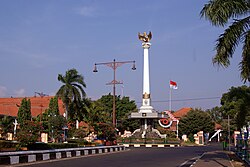Jepara is a town in the province of Central Java, Indonesia. Jepara is on the north coast of Java, northeast of Semarang, not far from Mount Muria, with a population of 81,920 in mid-2022.[1] It is also the main town of Jepara Regency. Jepara is known for the Javanese teak wood carving art as well as the birthplace of Kartini, a pioneer in the area of women's rights for Indonesians.
Jepara | |
|---|---|
| Kecamatan Jepara | |
 Jepara Monument near the city square | |
| Nickname: The World Carving Centre | |
| Coordinates: 6°32′0″S 110°40′0″E / 6.53333°S 110.66667°E | |
| Country | Indonesia |
| Province | Central Java |
| Regency | Jepara Regency |
| Area | |
• Total | 27.05 km2 (10.44 sq mi) |
| Elevation | 768 m (2,520 ft) |
| Population (mid 2022) | |
• Total | 81,920 |
| • Density | 3,000/km2 (7,800/sq mi) |
| [1] | |
| Time zone | UTC+7 (WIB) |
| Website | [1] |
Demographics
editThe population of Jepara Regency is approximately 1.2 million people, 49.86% male and 50.14% female. On the productivity age basis, the considered working-group age (between 15 and 64 yo) dominates Jepara's population at 67.90%, meanwhile the rest of 25.55% and 6.55% belong to the children and retired-people groups, respectively.
Jepara people are originally rooted as Javanese and religiously speaking, over 98% are Muslim.
The village of Plajan and the village of Tempur have a comparatively multi-religious population.[2]
History
editIn the 16th century, Jepara was an important port; in early 1513, its king, Yunnus (Pati Unus) led an attack against Portuguese Malacca. His force is said to have been made up of one hundred ships and 5000 men from Jepara and Palembang but was defeated. Between 1518 and 1521 he ruled over Demak. The rule of Ratu ('Queen') Kalinyamat in the latter 16th century was, however, Jepara's most influential. Jepara again attacked Malacca in 1551 this time with Johor but was defeated, and in 1574 besieged Malacca for three months.[3]
It was the site of a Dutch fort in the 17th century. It is the birthplace of Indonesian national heroine Kartini.[4]
Contemporary Jepara
editThe population is almost entirely Javanese and over 95% Muslim. As a pesisir ('coastal') area many traders from around the world landed in Jepara centuries ago. As a result, some of Jepara's residents have at part European, Chinese, Arabs, Malay or Bugis ancestry.[citation needed]
Climate
editJepara has a tropical monsoon climate (Am) with moderate to little rainfall from May to October and heavy to very heavy rainfall from November to April.
| Climate data for Jepara | |||||||||||||
|---|---|---|---|---|---|---|---|---|---|---|---|---|---|
| Month | Jan | Feb | Mar | Apr | May | Jun | Jul | Aug | Sep | Oct | Nov | Dec | Year |
| Mean daily maximum °C (°F) | 30.6 (87.1) |
30.5 (86.9) |
30.9 (87.6) |
31.8 (89.2) |
31.9 (89.4) |
32.1 (89.8) |
32.5 (90.5) |
33.3 (91.9) |
34.2 (93.6) |
34.2 (93.6) |
33.1 (91.6) |
31.7 (89.1) |
32.2 (90.0) |
| Daily mean °C (°F) | 26.4 (79.5) |
26.4 (79.5) |
26.5 (79.7) |
27.2 (81.0) |
27.1 (80.8) |
26.8 (80.2) |
26.5 (79.7) |
26.9 (80.4) |
27.7 (81.9) |
28.2 (82.8) |
27.8 (82.0) |
26.9 (80.4) |
27.0 (80.7) |
| Mean daily minimum °C (°F) | 22.2 (72.0) |
22.3 (72.1) |
22.2 (72.0) |
22.6 (72.7) |
22.4 (72.3) |
21.5 (70.7) |
20.6 (69.1) |
20.6 (69.1) |
21.3 (70.3) |
22.2 (72.0) |
22.6 (72.7) |
22.2 (72.0) |
21.9 (71.4) |
| Average rainfall mm (inches) | 646 (25.4) |
481 (18.9) |
363 (14.3) |
180 (7.1) |
103 (4.1) |
55 (2.2) |
27 (1.1) |
20 (0.8) |
41 (1.6) |
86 (3.4) |
199 (7.8) |
442 (17.4) |
2,643 (104.1) |
| Source: Climate-Data.org[5] | |||||||||||||
Kingdoms
editGallery
edit-
Mosque in Jepara, Pati Regency
Notes
edit- ^ a b Badan Pusat Statistik, Jakarta, 2023.
- ^ "Central Java Village Shows That Unity in Diversity Is Possible Archived 2016-03-05 at the Wayback Machine." Jakarta Globe. Retrieved on August 26, 2015.
- ^ Ricklefs, M.C. (1991). A History of Modern Indonesia since c.1300, 2nd Edition. London: MacMillan. p. 38. ISBN 0-333-57689-6.
- ^ Taylor, Jean Stewart (1976). Raden Ajeng Kartini. pp. 639–661.
- ^ "Climate: Jepara". Climate-Data.org. Retrieved 15 November 2020.
References
edit- Witton, Patrick (2003). Indonesia (7th ed.). Melbourne: Lonely Planet. pp. 259–260. ISBN 1-74059-154-2.
- Blie.Info Places To Go in Jepara
